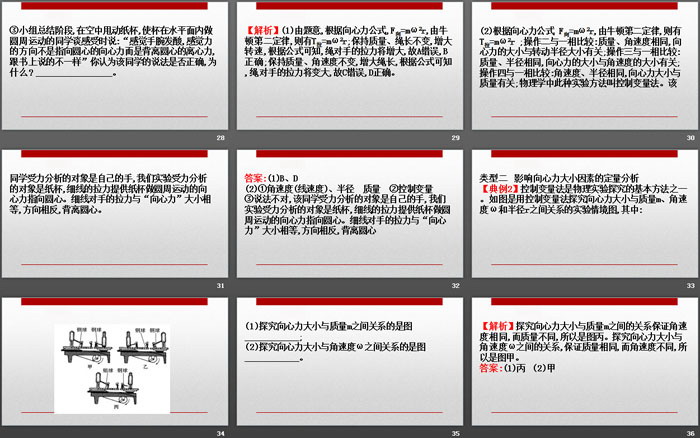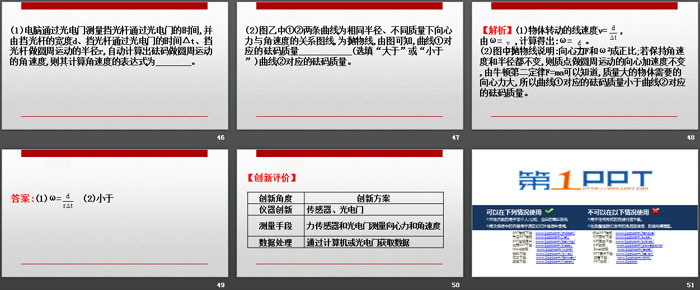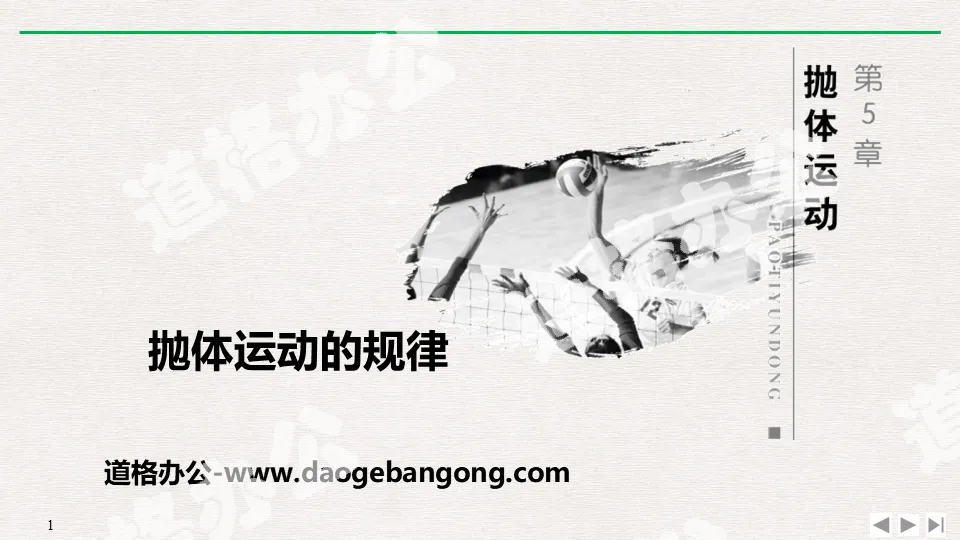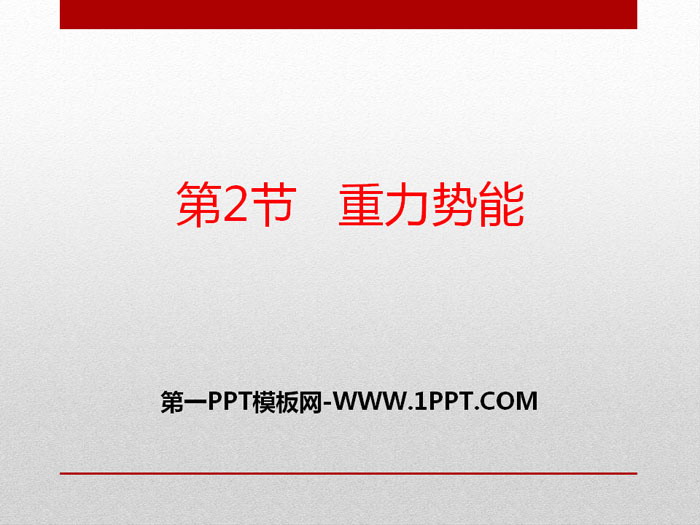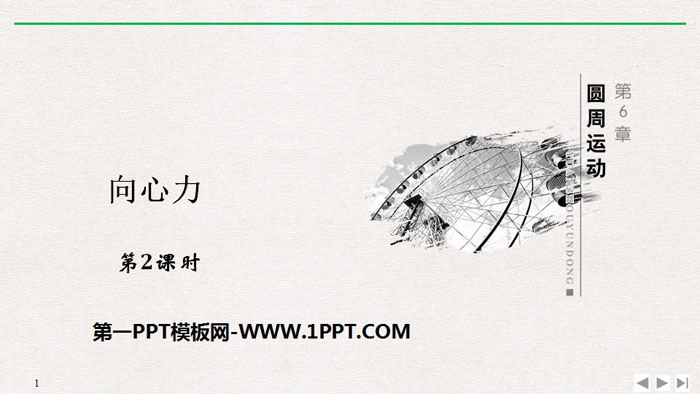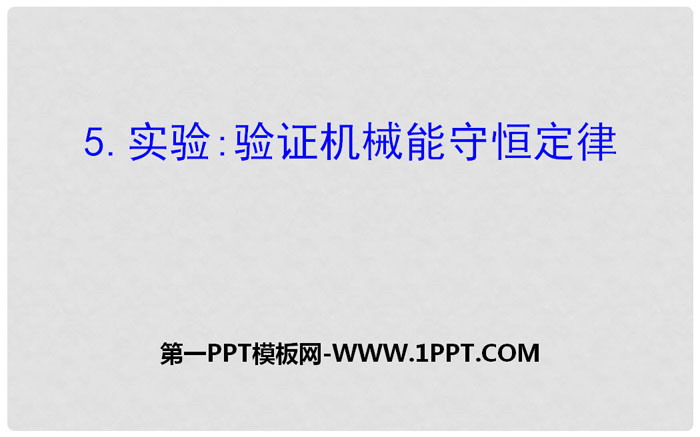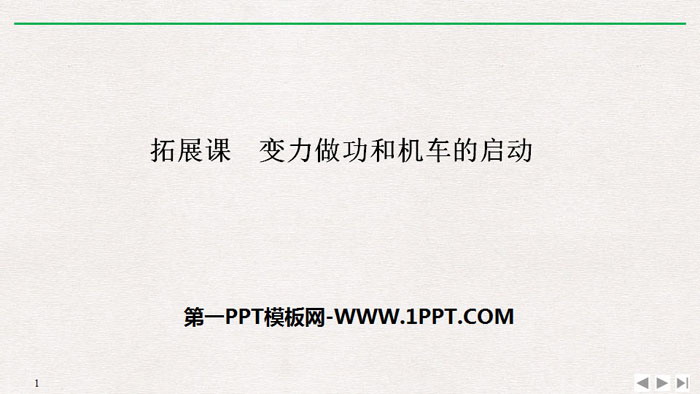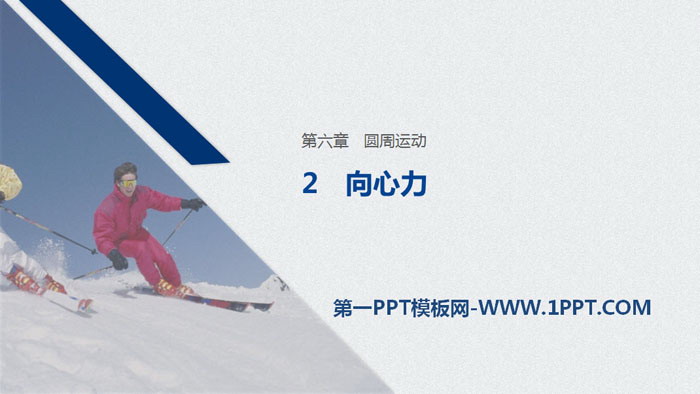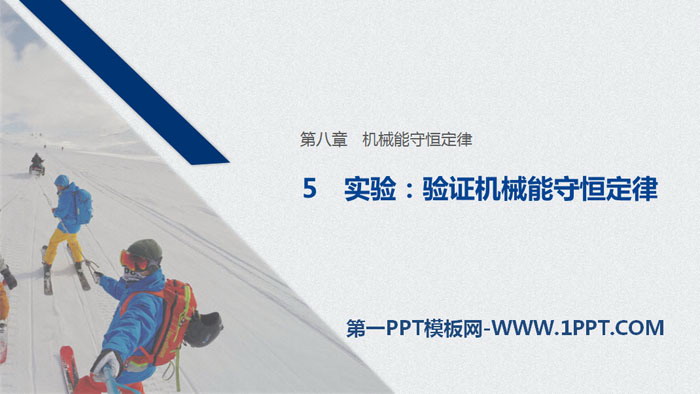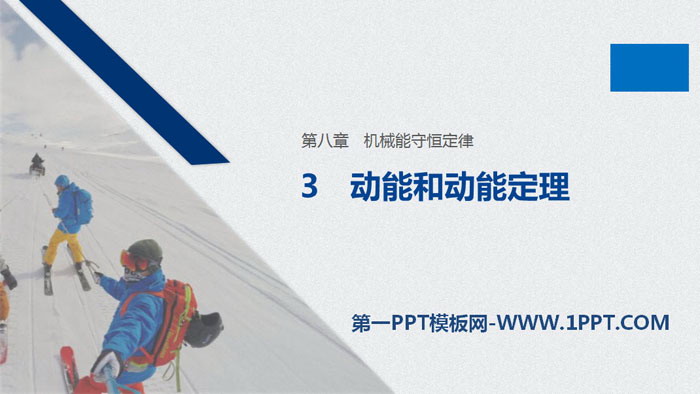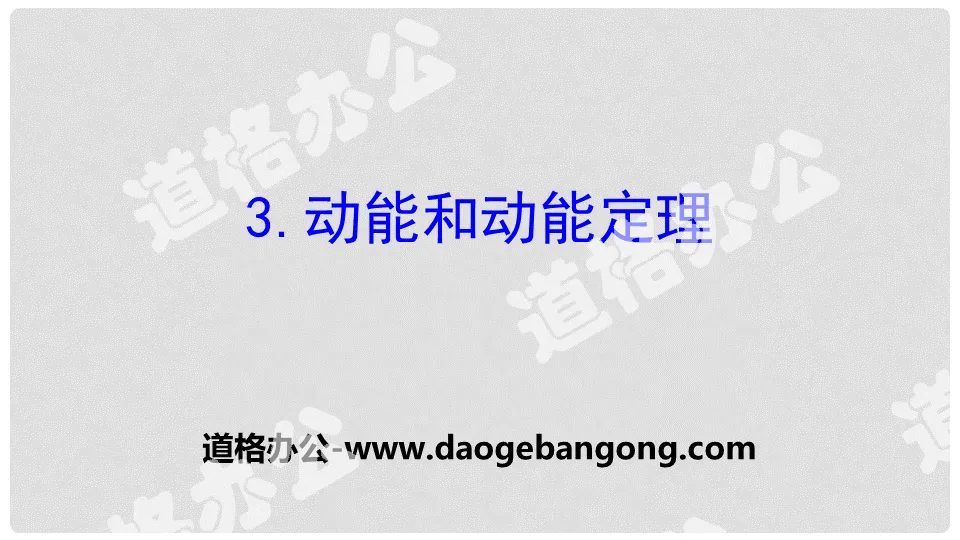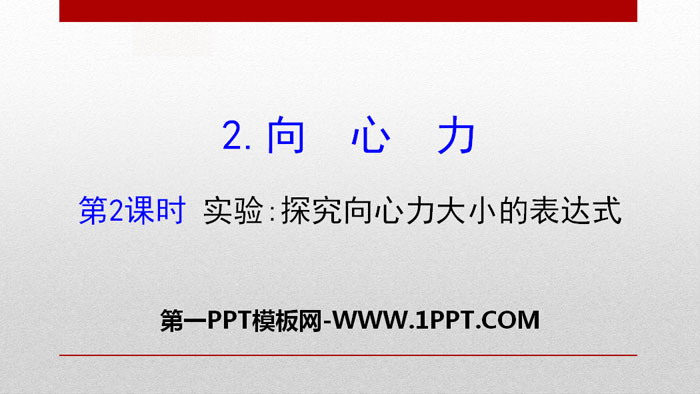
| Category | Format | Size |
|---|---|---|
| People's Education Press High School Physics Compulsory Course II | pptx | 6 MB |
Description
"Centripetal Force" Circular Motion PPT (Experiment in Lesson 2: Exploring the Expression of Centripetal Force)
Part 1: Essential knowledge and foundation of literacy
【Purpose】
1. Qualitatively perceive what factors are related to the size of the centripetal force.
2. Learn to use the centripetal force demonstrator.
3. Explore the quantitative relationship between centripetal force and mass, angular velocity, and radius.
[Experimental Principle and Design]
1. Experimental principle
Exploration method: control variable method.
2. Experimental design
(1) Qualitative perception experiment design idea: As shown in the figure, a thin thread is threaded through the ballpoint pen rod, one end is tied to a small object, the other end is held with one hand, and the other hand grasps the ballpoint pen rod and turns it hard. To make a small object move in a circular motion, it can be approximately considered that the tensile force of the thin wire acting on the small object provides the _______ required for the circular motion, and the tensile force of the thin wire can be judged by the feeling of the hand holding the thin wire.
(2) Quantitative analysis experimental design ideas:
① Control the mass and radius of the ball unchanged, and explore the relationship between centripetal acceleration and _______.
② Control the mass and angular velocity of the ball unchanged, and explore the relationship between centripetal acceleration and _____.
③Control the radius and angular velocity of the ball unchanged, and explore the relationship between centripetal acceleration and _____.
Centripetal Force PPT, Part 2: Key Competencies·Quality Formation
【experiment procedure】
1. Experimental steps
1. Qualitative perception of factors related to the size of centripetal force.
(1) Under the condition that the mass and angular velocity of the small object remain unchanged, experiments are conducted by changing the radius of the small object's circular motion.
(2) Under the condition that the mass of the small object and the radius of the circular motion remain unchanged, the experiment is conducted by changing the angular velocity of the object.
(3) Change to small objects of different masses, and repeat the above operations under the condition that the angular velocity and radius remain unchanged.
2. Quantitative analysis of the relationship between centripetal force and mass, angular velocity, and radius.
Rotating the handle at a uniform speed can make the cone wheel, long groove and short groove rotate at a uniform speed, and the small ball in the groove will also make a uniform circular motion. At this time, the ball squeezes the baffle outward, and the reaction force of the baffle on the ball provides the centripetal force for the ball to move in a uniform circular motion. At the same time, the force of the small ball pressing the baffle causes the other end of the baffle to compress the spring in the spring force measuring sleeve. The compression amount of the spring can be read from the scale, and the reading shows the centripetal force.
(1) Place two small balls with the same mass on the long slot and the short slot so that their rotation radii are the same. Adjust the belt on the cone wheel so that the angular speeds of the two balls are different. Note the relationship between the magnitude of the centripetal force and the angular velocity.
(2) Keep the mass of the two balls unchanged and increase the rotation radius of the balls on the long groove. Adjust the belt on the cone wheel so that the angular speeds of the two balls are the same. Note the relationship between the size of the centripetal force and the radius.
(3) Change to small balls with different masses, so that the rotation radii of the two small balls are the same. Adjust the belt on the cone wheel so that the angular speeds of the two balls are the same. Pay attention to the relationship between the size of centripetal force and mass.
(4) Repeat the above experiment several times.
2. Data collection and analysis
1.m and r are certain
2.m and ω are certain
3.r and ω are certain
4. Make images of F direction -ω2, F direction -r, and F direction -m respectively.
5.Experimental conclusion:
(1) When the mass and radius are constant, the size of the centripetal force is proportional to the square of the angular velocity.
(2) When the mass and angular velocity are constant, the size of the centripetal force is proportional to the radius.
(3) When the radius and angular velocity are constant, the size of the centripetal force is proportional to the mass.
【Think·Discussion】
1. What safety issues should you pay attention to when using the centripetal force demonstrator? (Scientific attitude and responsibility)
Tip: Tighten the cross arm fastening screws to prevent balls and other parts from flying out and causing accidents.
2. How to read the number of grids of the force measuring sleeve when using the centripetal force demonstrator? (Scientific inquiry)
Tip: When shaking the handle, strive to accelerate slowly, and pay attention to the number of grids on one of the force measuring sleeves. When the predetermined number of grids is reached, the rotation speed is kept uniform and constant.
Centripetal Force PPT, Part 3: Experimental Research and Analysis·Literacy Transfer
Type 1: Qualitative analysis of factors affecting the size of centripetal force
[Typical Example 1] As shown in the figure, students were divided into groups to explore the factors that affect the size of the centripetal force. Students tie a paper cup (containing 30 mL of water) with a string and swing it in the air so that the cup makes a circular motion in the horizontal plane to feel the centripetal force.
(1)The correct one of the following statements is ____________.
A. Keep the mass and rope length unchanged, increase the rotation speed, and the pulling force of the rope on the opponent will remain unchanged.
B. Keep the mass and rope length unchanged, increase the rotation speed, and the pulling force of the rope on the opponent will increase.
C. Keep the mass and angular velocity unchanged, increase the rope length, and the pulling force of the rope on the opponent will remain unchanged.
D. Keep the mass and angular velocity unchanged, increase the rope length, and the pulling force of the rope on the opponent will increase.
(2) As shown in Figure A, tie a node A 40 cm away from the center of the cup and a node B 80 cm away from the center of the cup. One student in the study group records the time with a watch, another student operates, and the remaining students record the experiment data:
Operation 1: Hold the knot A in your hand and make the cup move once per second in the horizontal direction to experience the magnitude of the centripetal force.
Operation 2: Holding knot B, make the cup move once per second in the horizontal direction to experience the magnitude of the centripetal force.
Operation 3: Holding knot A in your hand, make the cup move two times per second in the horizontal direction to experience the magnitude of the centripetal force.
Operation 4: Hold knot A in your hand, then add 30 mL of water to the cup, make the cup move one circle per second in the horizontal direction, and experience the size of the centripetal force.
Then: ① Compare operation two with operation one: the mass and angular velocity are the same, and the size of the centripetal force is related to the size of the radius of rotation;
Compare operation three with one: the mass and radius are the same, and the size of the centripetal force is related to the size of the angular velocity;
Comparing operation four with one: ____________ is the same, and the size of the centripetal force is related to ____________;
②This experimental method in physics is called the __________ method.
③ During the group summary stage, students who swung the paper cups in the air to make circular motions in the horizontal plane said: "My wrists feel sore, and the direction of the force I feel is not the centripetal force pointing towards the center of the circle but the centrifugal force away from the center of the circle. Follow the instructions in the book." "It's different." Do you think the student's statement is correct and why? _______________.
[Analysis] (1) From the meaning of the question, according to the centripetal force formula, F direction = mω2r, and according to Newton’s second law, T pull = mω2r; keep the mass and rope length unchanged, increase the rotation speed, according to the formula, we can see that the rope is opposite to The pulling force of the rope will increase, so A is wrong and B is correct; keep the mass and angular velocity unchanged and increase the length of the rope. According to the formula, it can be seen that the pulling force of the rope on the opponent will become larger, so C is wrong and D is correct.
(2) According to the centripetal force formula F = mω2r, and Newton’s second law, T pull = mω2r; operation two is compared with one: the mass and angular velocity are the same, and the size of the centripetal force is related to the radius of rotation; operation three is the same as one Comparison: the mass and radius are the same, the size of the centripetal force is related to the size of the angular velocity; operation four is compared with one: the angular velocity and radius are the same, the size of the centripetal force is related to the mass; in physics, this experimental method is called the controlled variable method. The object of the student's force analysis is his own hand. The object of our experimental force analysis is a paper cup. The tension of the thin wire provides the centripetal force for the paper cup to move in a circular motion toward the center of the circle. The pulling force of the thin line on the opponent is equal to the "centripetal force" and opposite in direction, away from the center of the circle.
Type 2: Quantitative analysis of factors affecting the size of centripetal force
[Typical Example 2] The controlled variable method is one of the basic methods of physical experimental exploration. The figure is an experimental situation diagram using the control variable method to explore the relationship between the centripetal force and mass m, angular velocity ω and radius r, where:
(1) The diagram that explores the relationship between the centripetal force and mass m is ____________;
(2) The graph that explores the relationship between the centripetal force and the angular velocity ω is ____________.
[Analysis] Explore the relationship between the centripetal force and the mass m to ensure that the angular velocity is the same but the mass is different, so it is Figure C. Explore the relationship between the centripetal force and the angular velocity ω to ensure that the mass is the same but the angular velocity is different, so it is picture A.
Answer: (1) C (2) A
Type 3: Experimental Innovation
Verify the centripetal force expression using a conical pendulum
[Typical Example 3] As shown in the figure, it is an experiment of "using a conical pendulum experiment to verify the centripetal force formula". A small steel ball with a mass m is suspended under the thin wire, and the upper end of the thin wire is fixed at point O. Place a white paper with several concentric circles drawn on it on a horizontal table, so that the small steel ball is located on the concentric circles when it is at rest (the thin wire is tensioned). Use your hand to drive the small steel ball to make a uniform circular motion in the horizontal plane, and then separate your hand from the ball. (The local acceleration due to gravity is g)
(1) Use a stopwatch to record the time t for the small steel ball to move n times, so as to measure the period of the steel ball's uniform circular motion at this time T=____________.
(2) Then use the circle on the paper to measure the radius R of the small steel ball making uniform circular motion; the centripetal force F required for the small steel ball to make uniform circular motion can be calculated =____________.
(3) Measure the length L of the string, and the resultant force F on the small steel ball when it makes uniform circular motion = ____________ (the diameter of the small steel ball can be ignored compared with the length of the rope).
(4) This experimental method is simple and easy to implement, but there are several factors that may affect the success of the experiment. Please write one: ____________________.
Keywords: PPT courseware for high school physics compulsory course 2 from the People's Education Press is free to download, centripetal force PPT download, circular motion PPT download, experimental exploration of the expression of centripetal force magnitude PPT download, .PPT format;
For more information about the PPT courseware "Circular Motion Centripetal Force Experiment to Explore the Expression of Centripetal Force", please click the Circular Motion PPT Centripetal Force PPT Experiment to Explore the Expression of Centripetal Force PPT tag.
"Centripetal Force" Circular Motion PPT quality courseware (understanding of the concept of centripetal force and application of expressions in the second lesson):
"Centripetal Force" circular motion PPT high-quality courseware (understanding of the concept of centripetal force and application of expressions in the second lesson) The first part of the content: core literacy goals, physical concepts, and understanding of the expression of centripetal force. Scientific thinking can analyze the source of centripetal force through experiments and master...
"Centripetal Force" Circular Motion PPT high-quality courseware (first lesson experiment: exploring the expression of the size of centripetal force):
"Centripetal Force" Circular Motion PPT high-quality courseware (first lesson experiment: exploring the expression of the size of centripetal force) The first part of the content: core literacy goals, physical concepts, centripetal force, its characteristics, and expressions. Scientific thinking: Be able to measure and analyze experimental data and obtain experimental results..
"Centripetal Force" Circular Motion PPT Excellent Courseware:
"Centripetal Force" Circular Motion PPT Excellent Courseware Part One Content: Learning Objectives 1. Know what centripetal force is, know the role of centripetal force, and know that it is named according to the effect of force. 2. Be able to analyze the source of centripetal force and master the expression of centripetal force , and can...
File Info
Update Time: 2024-06-25
This template belongs to Physics courseware People's Education Press High School Physics Compulsory Course II industry PPT template
"Centripetal Force" Circular Motion PPT (Experiment in Lesson 2: Exploring the Expression of Centripetal Force) Simple campus recruitment activity planning plan summary enterprise and institution recruitment publicity lecture PPT template is a general PPT template for business post competition provided by the manuscript PPT, simple campus recruitment activity planning plan summary enterprise and institution recruitment promotion Lecture PPT template, you can edit and modify the text and pictures in the source file by downloading the source file. If you want more exquisite business PPT templates, you can come to grid resource. Doug resource PPT, massive PPT template slide material download, we only make high-quality PPT templates!
Tips: If you open the template and feel that it is not suitable for all your needs, you can search for related content "Centripetal Force" Circular Motion PPT (Experiment in Lesson 2: Exploring the Expression of Centripetal Force) is enough.
How to use the Windows system template
Directly decompress the file and use it with office or wps
How to use the Mac system template
Directly decompress the file and use it Office or wps can be used
Related reading
For more detailed PPT-related tutorials and font tutorials, you can view: Click to see
How to create a high-quality technological sense PPT? 4 ways to share the bottom of the box
Notice
Do not download in WeChat, Zhihu, QQ, built-in browsers, please use mobile browsers to download! If you are a mobile phone user, please download it on your computer!
1. The manuscript PPT is only for study and reference, please delete it 24 hours after downloading.
2. If the resource involves your legitimate rights and interests, delete it immediately.
3. Contact information: service@daogebangong.com
"Centripetal Force" Circular Motion PPT (Experiment in Lesson 2: Exploring the Expression of Centripetal Force), due to usage restrictions, it is only for personal study and reference use. For commercial use, please go to the relevant official website for authorization.
(Personal non-commercial use refers to the use of this font to complete the display of personal works, including but not limited to the design of personal papers, resumes, etc.)
Preview




